¶ Introduction
The landing stage of a flight is usually the path from 50 ft above the landing threshold and the place where an airplane comes to a complete stop. The 50 ft point is sometimes referred to landing screen height, the same as screen height on the takeoff path.
The landing screen height is fixed to 50 ft for all performance classes of airplanes. Unlike the takeoff screen height which is 35 ft for Class A and 50 ft for Class B airplanes.
The main 3 things which pilots should consider while preparing for landing is weight, speed and landing distance.
¶ Weight
The maximum weight for landing is the lesser of:
- Field length limit weight.
- Landing climb limit weight.
- Structural limit weight.
Field length limit weight is the weight limited by airplane performance under certain conditions. Usually this weight requires limiting on mountain airfields with short runways.
Landing climb weight is the maximum weight to achieve landing climb requirements (in case of go around).
Structural limit weight is the manufacturer's certified landing weight limit defined in its operational manual.
In some circumstances landing with exceeded structural limit weight is approved by the manufacturer. In that case special maintenance procedures and checks should be applied upon arrival.
¶ Speed
During the approach down to the landing screen height the airplane must maintain the landing reference speed, known as VREF.
Under regulations covering Class A airplanes, VREF should not be to less than:
1. 1.23 times of the stall reference speed in the landing configuration.
2. the speed of minimum control in the landing configuration.
Boeing Flight Crew Training Manual (FCTM) command speed adjustments should be applied during approach and landing.
1. When using autothrottle, position command speed to VREF + 5.
2. If autothrottle is disconnected or is planned to be disconnected prior to landing, add one half of the steady headwind plus the full gust increment above steady wind. The minimum command speed setting is VREF + 5, maximum is VREF + 20 or landing flap placard speed minus 5 knots, whichever is lower.
VREF is a very important speed since the landing distances in airplane manuals are based on flying at VREF. If the pilot does not follow VREF during the approach, the calculated landing distance will not be achieved.
¶ Landing distance
The landing distance can be divided into 2 parts: airborne section and ground roll. The airborne section starts from 50 ft of landing screen height and ends on touchdown, when the main wheels touch the landing surface. The airborne section is usually given as 1000 ft. The second section, ground roll, is a distance from touchdown until full stop. However, in normal operations airplanes do not stop on the runway, they rather slow down to a safe speed to vacate the runway and continue taxi to the ramp.
Landing distance required (LDR) is the summary of airborne and ground roll sections. LDR can be calculated using the airplane manual.
Landing distance available (LDA) is the length of a runway from one threshold to the other. Sometimes there are displaced thresholds, which make some parts of the runway unusable for landing.
Pilots need to make sure that the LDR does not exceed the LDA. Always check the LDA on arrival and alternate airfields during flight preparation.
¶ Practical example
¶ Conditions and objectives
Conditions:
Airplane: Boeing 737-800 with winglets and 26K engine rating
Maximum landing weight: 65770 kg
Actual landing weight: 50000 kg
LDA: 2400 m
Runway condition: dry, 1% slope.
Headwind component: 10 kt.
Temperature: +26°
Pressure altitude: 4000 ft.
Objectives:
1. Find landing field limit weight.
2. Find landing climb limit weight.
3. Find VREF.
4. Find LDR.
We need to use the Boeing 737 Flight Crew Operational Manual (FCOM) and Quick Reference Handbook (QRH). Make sure you are going to use correct data for certain airplane configuration, engine rating and aviation authority rules.
¶ Interpolation
Performance data provided in tables view are always shown as round values to simplify the calculations.
Pilots have two ways to deal with it: use the next higher number (Boeing officially states this) or simply the closest number to make quick calculations and optionally provide for extra margin. Also sometimes it is reasonable to interpolate between two near numbers.

where:
X - input variable ;
Xlow - lowest value of two in table ;
Xhigh - highest value of two in table ;
Flow - lowest corresponding to X value in table ;
Fhigh - highest corresponding to X value in table.
Within this document we sometimes are going to use closest "worse" numbers to avoid long calculations.
¶ Calculations
¶ Field limit weights
Go to FCOM - Performance Dispatch -- Landing -- Landing Field Limit Weight -- Dry Runway.
1. First we need to correct the field length for the wind. Enter the appropriate table with field length and wind headwind component.
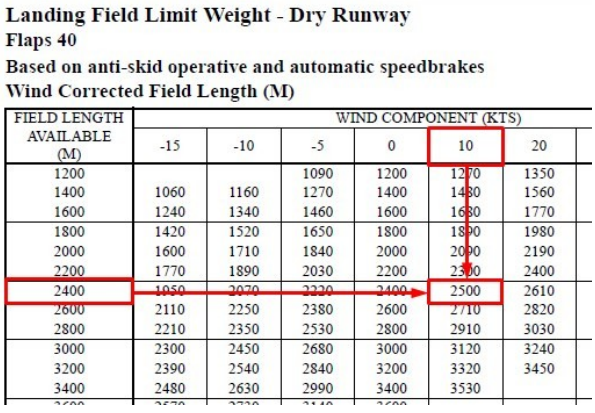
Result: 2500 m of wind corrected field length. Moving forward.
2. Enter the Field Limit Weight table to find the appropriate limit using corrected field length and pressure altitude.
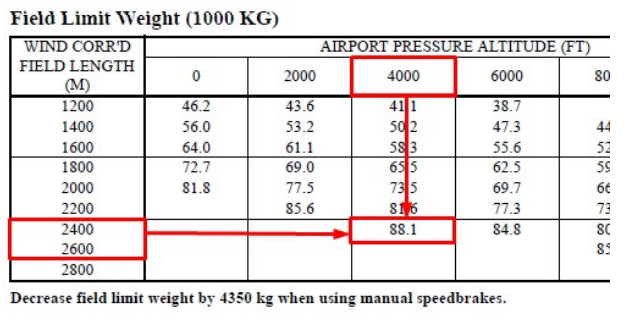
Result: 88100 kg of landing field limit weight.
Go to FCOM - Performance Dispatch -- Landing -- Landing Climb Limit Weight.
3. Next we need to find the climb limit weight. It is a function of temperature and airfield pressure altitude.
Enter the appropriate table with these data.
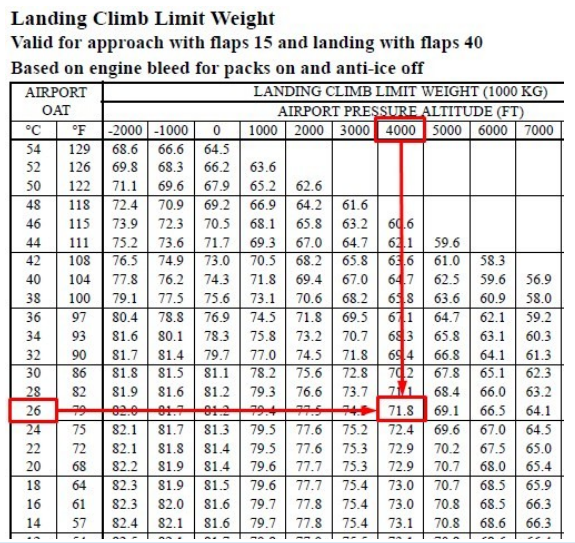
Result: 71800 kg of climb limit weight.
Let us compare all the results with respect to field limit weight.
| Field limit weight | 88100 kg |
| Climb limit weight | 71800 kg |
| Structural limit weight | 65770 kg |
As we see, landing performance limits are mostly insignificant with long runways. Our most significant performance limit is the climb limit weight of 71800 kg. But the final limit is the structural limit weight because it is the lowest.
¶ VREF
Go to FCOM - Performance Inflight -- VREF.
4. The next step is to find VREF. It is a function of flap setting and landing weight. Our landing weight today is 50000 kg.
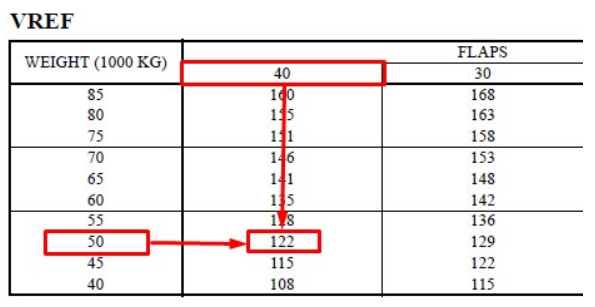
Result: VREF is 122 kt.
¶ Landing distance required
Go to QRH -- Performance Inflight -- Advisory information.
5. The next goal is to find the required landing distance. QRH provides the basic LDR for certain conditions with all needed adjustments. We will try to use Autobrake 2 if within the limits, to safe our brakes.
Accurately follow all the adjustments.
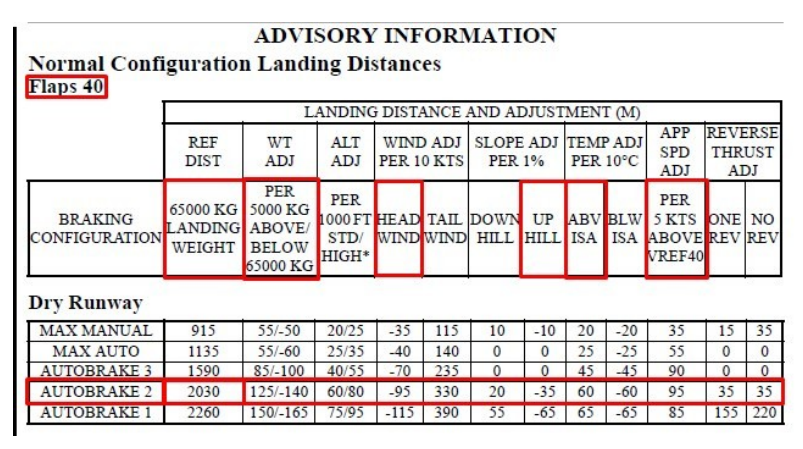
Let us go through this table step by step.
- Basic distance. For 65000 kg of reference weight the basic distance is 2030 m.
- Weight adjustment. Our actual landing weight is 50000 kg, this is 15000 less than the reference weight.
As stated in the table, we should deduct 140 m from every 5000 kg of difference. So, 2030 -- (140 * 3) = 1610 m. - Altitude adjustment. We need to use the notes below the
table:

STD adjustment is 60 ft and pressure altitude is 4000 ft. So 1610 + (60 * 4) = 1850 m. - Wind adjustment. Our headwind component today is 10 kt,
So, 1850 -- 95 = 1755 m. - Runway slope adjustment. 1755 -- 35 = 1720 m.
- Temperature adjustment. Here we are going to deal with the standard atmosphere (ISA) and its deviation.
As per ISA, the temperature rate is 2°C for each 1000 ft. Therefore:ISA Temperature = 15 -- 2 \* altitude (in 1000 ft). Our pressure altitude is 4000 ft, so ISA temperature = 15 -- 2 \* 4 = +7°C.\ Actual temperature is +26°C, therefore ISA deviation is 19 °C. We need to add 60 m twice: 1720 + 60 \* 2 = 1840 m. - Approach speed adjustment.
We are going to use standard VREF + 5 adjustment. So, 1840 + 95 = 1935 m. - Reverse thrust adjustment. No need, both reversers are in use.
Result: LDR is 1935 m.
¶ Example results
The airplane is going to land with the following parameters:
Landing weight: 55000 kg
Performance limit landing weight: 71800 kg [Climb limit weight]
VREF = 122 kt.
Command speed: 127 kt [Autothrottle is use].
LDR: 1935 m.
LDA: 2400 m.
Autobrake: 2.
¶ Other circumstances
It goes without saying that the airplane manufacturer provides performance data for different situations.
You can use manuals, such as FCOM and QRH to get all necessary and relevant information.
For example, any runway condition is taken into account there.
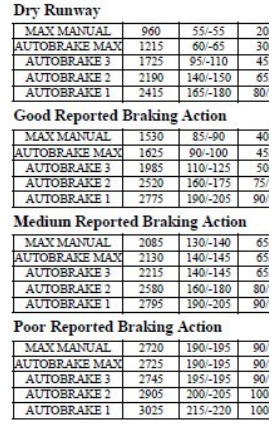
Any other special or abnormal landing distance calculations could be found in a special chapter "Non-Normal Configuration Landing Distance" in QRH.
Always check that you use correct performance data for a particular flight. Do not mix it up because it could lead to unexpected airplane behaviour or insufficient performance.
- None
- None
- VID 531824 - Creation
- VID 200696 - Wiki Integration
- VID 496402 - Wiki.js integration